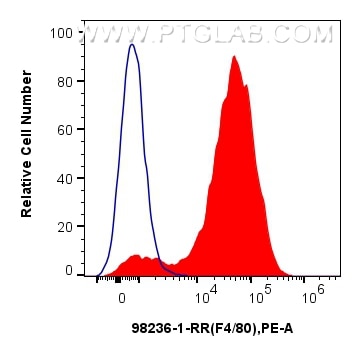Tested Applications
| Positive FC detected in | Balb/c mouse peritoneal macrophages |
Recommended dilution
| Application | Dilution |
|---|---|
| Flow Cytometry (FC) | FC : 0.25 ug per 10^6 cells in 100 μl suspension |
| This reagent has been tested for flow cytometric analysis. It is recommended that this reagent should be titrated in each testing system to obtain optimal results. | |
| Sample-dependent, Check data in validation data gallery. | |
Published Applications
| FC | See 1 publications below |
Product Information
98236-1-RR targets F4/80 in FC applications and shows reactivity with mouse samples.
| Tested Reactivity | mouse |
| Cited Reactivity | mouse |
| Host / Isotype | Rabbit / IgG |
| Class | Recombinant |
| Type | Antibody |
| Immunogen |
CatNo: Eg0788 Product name: Recombinant Mouse EMR1/ADGRE1/(F4/80) protein (His Tag) Source: mammalian cells-derived, pHZ-KIsec-C-6*HIS Tag: C-6*HIS Domain: 28-644 aa of NM_010130.4 Sequence: QTLGGVNECQDTTTCPAYATCTDTTDSYYCTCKRGFLSSNGQTNFQGPGVECQDVNECLQSDSPCGPNSVCTNILGRAKCSCLRGFSSSTGKDWILGSLDNFLCADVDECLTIGICPKYSNCSNSVGSYSCTCQPGFVLNGSICEDEDECVTRDVCPEHATCHNTLGSYYCTCNSGLESSGGGPMFQGLDESCEDVDECSRNSTLCGPTFICINTLGSYSCSCPAGFSLPTFQILGHPADGNCTDIDECDDTCPLNSSCTNTIGSYFCTCHPGFASSNGQLNFKDLEVTCEDIDECTQDPLQCGLNSVCTNVPGSYICGCLPDFQMDPEGSQGYGNFNCKRILFKCKEDLILQSEQIQQCQAVQGRDLGYASFCTLVNATFTILDNTCENKSAPVSLQSAATSVSLVLEQATTWFELSKEETSTLGTILLETVESTMLAALLIPSGNASQMIQTEYLDIESKVINEECKENESINLAARGDKMNVGCFIIKESVSTGAPGVAFVSFAHMESVLNERFFEDGQSFRKLRMNSRVVGGTVTGEKKEDFSKPIIYTLQHIQPKQKSERPICVSWNTDVEDGRWTPSGCEIVEASETHTVCSCNRMANLAIIMASGELTME Predict reactive species |
| Full Name | EGF-like module containing, mucin-like, hormone receptor-like sequence 1 |
| Calculated Molecular Weight | 102 kDa |
| GenBank Accession Number | NM_010130.4 |
| Gene Symbol | F4/80 |
| Gene ID (NCBI) | 13733 |
| Conjugate | Unconjugated |
| Form | Liquid |
| Purification Method | Protein A purfication |
| UNIPROT ID | Q61549 |
| Storage Buffer | PBS with 0.09% sodium azide, pH 7.3. |
| Storage Conditions | Store at 2 - 8°C. Stable for one year after shipment. |
Background Information
Mouse F4/80, also named as EMR1 and Gpf480, is a 160-kDa cell surface glycoprotein which is a member of the EGF TM7 family. The F4/80 molecule is solely expressed on the surface of macrophages and serves as a marker for mature macrophage tissues, including Kupffer cells in liver, splenic red pulp macrophages, brain microglia, gut lamina propria and Langerhans cells in the skin. The function of F4/80 is unclear, but it is speculated to be involved in macrophage adhesion events, cell migration or as a G protein-coupled signaling component of macrophages.
Protocols
| Product Specific Protocols | |
|---|---|
| FC protocol for F4/80 antibody 98236-1-RR | Download protocol |
| Standard Protocols | |
|---|---|
| Click here to view our Standard Protocols |
Publications
| Species | Application | Title |
|---|---|---|
Inflammation Moxibustion Alleviates Inflammation via SIRT5-mediated Post-translational Modification and Macrophage Polarization | ||
Can J Gastroenterol Hepatol Kupffer-Cell-Targeted Carboxylesterase 1f Knockdown Deteriorates Lipopolysaccharide/D-Galactosamine-Induced Acute Liver Failure Through Regulating Cellular Polarization in Mice |








